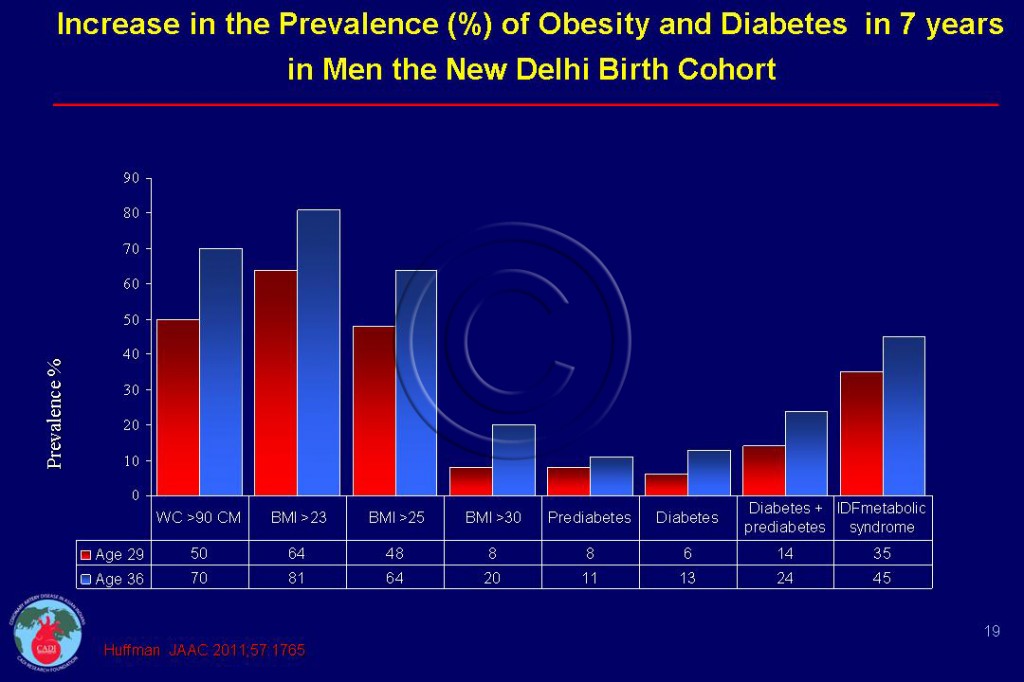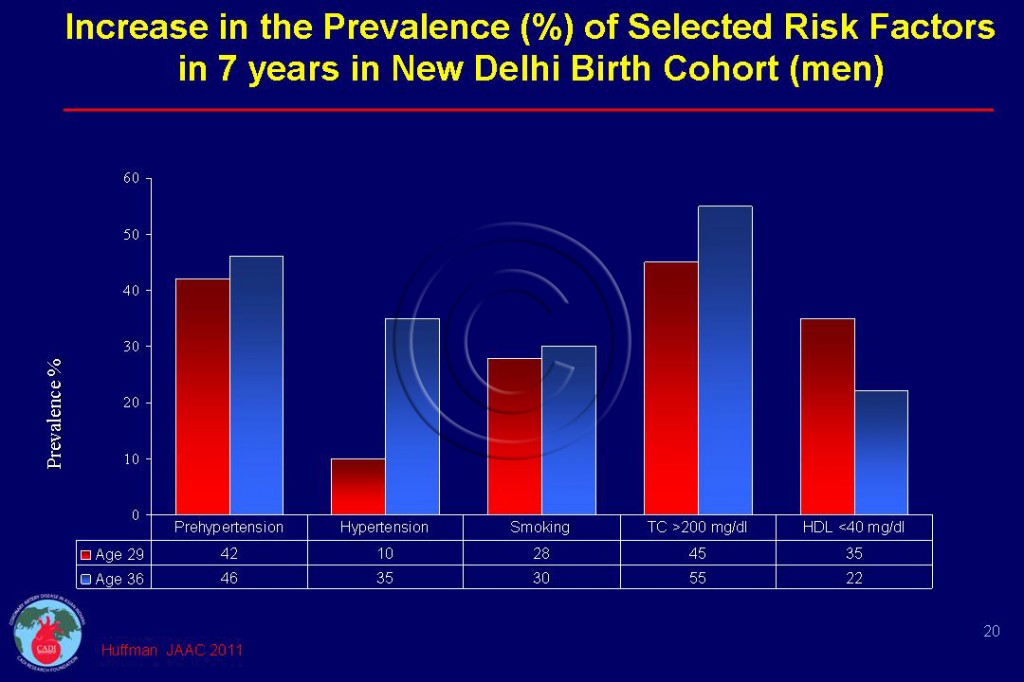Incidence of Risk Factors
- Among Indian Diasporas, the prevalence and incidence of risk factors are decreasing with the exception of diabetes and obesity.1 In sharp contrast, both of these are increasing in India. A recent report on the incidence of CVD (cardiovascular disease) risk factors from the New Delhi Birth Cohort sheds new light on the dynamics of the escalating prevalence and incidence of CVD risk factors in young Indians. The investigators reported the changes in risk factors among 1,100 young adult participants (mean age at baseline 29 years) followed for an average of 7 years (See New Delhi). Other studies also support the high incidence of risk factors at a young age.1
- The increase in the prevalence of risk factors in 7 years due to increased incidence is shown in Figures 019 and 020.2
- The average annual incidence of obesity was 2.0% in men and 2.2% in women. Average incidence of hypertension was 4.2% and 1.8% per year and the incidence of diabetes was 1.0% and 0.5% per year in men and women, respectively.2
- Whatever the cause, this rapid increase in CVD risk factors may reflect the huge transitions in income, wealth, and lifestyle occurring in other fast-growing cities in India and other low and middle-income countries.
- An estimated 32 to 47 million people in India are living with coronary artery disease (CAD).3, 4 The high incidence of CVD risk factors documented in the New Delhi Birth Cohort suggests that these numbers are likely to increase substantially over the next several decades. For instance, the prevalence of diabetes, already the highest in the world, is expected to reach 20% and the total number of Indians with diabetes would surpass more than 80 million within the next 20 years. Cities like Chennai, have already reported a diabetes prevalence of 20%.
- The increased healthcare costs will worsen poverty because families have to pay for more long-term healthcare services, medications, and rehabilitation. Subsequently, these costs will add severe strains to limited resources devoted to national healthcare expenditures.5
- The high incident rates of obesity, high blood pressure, and diabetes in this young urban Indian cohort are likely to lead to an even higher burden of CVD in this population in the near future. The high incidence of risk factors over such a short span of time in this young cohort could have implications for the use of appropriate risk screening and intervention strategies beginning at younger ages.2
- The seriousness of the consequences of the high incidence of risk factors should not be underestimated. The looming disease burden could overwhelm healthcare systems in India, which are struggling with the still prevalent communicable diseases (double burden of disease). The impact on families, worker productivity, international competitiveness in the global economy, and continued growth could be catastrophic and lead to serious social upheavals (see Tsunami of Heart Disease).
- The size of the epidemic requires urgent public health, policy, and healthcare responses. (See Prevention of Heart Disease Among Indians). There is urgent need for a life-course approach specifically emphasizing health promotion during childhood and adolescence, primary prevention for individuals with CVD risk factors, and secondary prevention for those with established CAD and stroke.2
Sources
1.Enas EA. How to Beat the Heart Disease Epidemic among South Asians: A Prevention and Management Guide for Asian Indians and their Doctors. Downers Grove: Advanced Heart Lipid Clinic USA; 2011.
2. Huffman M D, Prabhakaran D, Osmond C, et al. Incidence of cardiovascular risk factors in an Indian urban cohort results from the new delhi birth cohort. J Am Coll Cardiol. Apr 26 2011;57(17):1765-1774.
3. Gaziano TA, Bitton A, Anand S, Abrahams-Gessel S, Murphy A. Growing epidemic of coronary heart disease in low- and middle-income countries. Curr Probl Cardiol. Feb 2010;35(2):72-115.
4. Indrayan A. Forecasting vascular disease cases and associated mortality in India. 2010;http://www.whoindia.org/LinkFilesSept 25, 2010.
5. Paradis G, Chiolero A. The cardiovascular and chronic diseases epidemic in low- and middle-income countries a global health challenge. J Am Coll Cardiol. Apr 26 2011;57(17):1775-1777.



